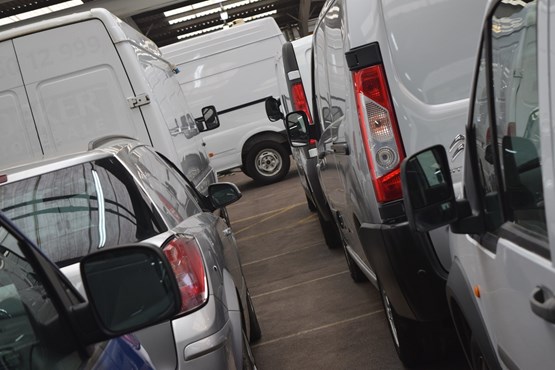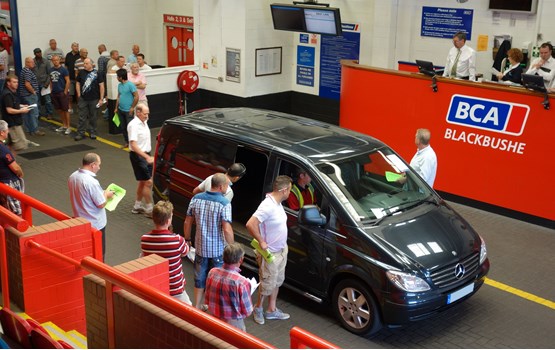Uncertainty following the general election created patchy buyer activity for used vans in May but BCA and Manheim Auctions reported improved average sale prices year-on-year.
At BCA, values improved by £21 to £6,452 month-on-month in May, with fleet, lease and dealer part-exchange values also increasing during the month.
Volumes continued to rise, with higher value corporate stock increasing its share of the mix, which impacted the average values achieved.
Year-on-year values continue to be well ahead, up by £560, equivalent to a 9.5% increase.
Average age and mileage continued to decline, largely as a result of the influx of younger rental stock over recent months.
BCA LCV operations director Duncan Ward said: “Buyer demand was patchy during May as professional buyers had a choice from a wide selection of stock and inevitably cherry-picked the best presented and most desirable vehicles. The bank holidays and half-term were additional distractions that fragmented demand during the month.
“The model mix continues to change as rental volumes ease, and 4x4 double-cab volumes continue to rise. The latter sector continues to experience price pressure and this can make guide values look overly optimistic. Condition and specification remain as important as ever and sellers should be aware that it is vital to appraise and value vehicles accurately to reflect current market sentiment.”
Manheim Auctions saw a slight softening of values (2.2%) in May over the previous month, but year-on-year prices were up by 7.3% to £5,040.
Matthew Davock, head of LCV at Manheim, said: “Overall performance in May was much more consistent than April, which was heavily impacted by bank holidays. The
commercial vehicle market showed particular strength in the second half of the month.”
Vans sold at Manheim in May were four months younger than the same month in 2016, with an average age of 63 months. Average mileage was down 3.6% year-on-year to 77,431. But this was the highest average mileage figure recorded so far in 2017, having risen every month since January.
Davock continued: “Vans with high mileage and high incidences of damage continue to dominate sales.
"Our analysis shows average damage recorded across all units of £834, a 17% year-on-year increase. Some vendors are seeing average damage per van in excess of £1,500. Vendors whose reserve pricing reflects these crucial factors are rewarded with buyer loyalty and market-leading performances.
“Buyer feedback received in May was mixed. April and early May were both slow from a retail activity perspective and proved to be the toughest months of the year. We saw a mixed buyer mood at our auctions, both in lane and online.

“The signs in the marketplace are positive. As we enter June, the supply of de-fleeted vans will remain low and there will be no bank holiday disruptions. We have a full month of both auction events and retail selling days which will drive strong activity in the overall market place.”
Sales of new vans have fallen in the past month, but Alex Wright, MD of Shoreham Vehicle Auctions (SVA), said this was not something to worry sellers.
Instead, he said, it should provide an opportunity for the used market. Smaller companies who are growing but are still hesitant about the outcome of Brexit are looking to spend £10,000-15,000 on a good quality used van rather than buying or financing £25,000-30,000 for a new one.
This type of behaviour by SMEs is likely to account for the fall the market has experienced in 2017.
Wright said: “The light commercial market is well tuned to the economy. Low interest rates and low unemployment figures, balanced out by higher inflation and a falling sterling, are enough for an SME to switch to a used purchase for the time being. Cashflow is king and they are able to change their purchasing decisions swiftly to protect their cash in the bank.
“There are no signs of larger companies putting new van purchases on hold or dramatically increasing their replacement cycles as they did between 2009 and 2013. We are still seeing a steady flow of three- to four-year-old used ex-fleet stock into the market.”
Wright said there was a big enough price gap between nearly-new demonstrator stock and three-year old-vans not to damage prices of the latter. SVA’s conversion rates have remained constant at between 80-90% at most of its auctions in 2017.
He added: “This price gap means independent dealers are buying in three-year-old stock and older to complement some of the newer stock they are able to source from the manufacturers.
"This gives them a mixed range of vehicles which helps them manage their risk effectively. Only if new van sales plummet will we see used prices going up above inflation again as demand threatens to exceed supply.”
The strength of bidding at most auctions in May was a mixed bag, with some sections struggling to get off the ground, while others soared, according to Steve Botfield, senior editor, commercial vehicles and motorcycles at CAP Red Book.
He said that generally, footfall seemed to be down, but there were plenty of professional buyers around.
Many seemed to be on a watching brief, however. While actual sales volumes were up by around 10% month on month, discerning trade buyers seemed reluctant to part with their cash, and auctioneers struggled at times to get realistic opening bids.

Botfield said: “We were expecting a significantly larger number of used LCVs entering the market during 2017.
"Some auction houses appear to have prepared for this with major players opening more sites, increasing the number of sale days, opening more lanes and even building larger new auction centres. But, so far, these increases haven’t really been felt. Three-year-old March plates are by far the most common ones we see in our auction research data but we are not seeing a big increase in 2014/14 (i.e. three-year-old) plate vehicles.
“Clearly something has changed. A number of leasing and rental companies are increasing their in-house remarketing activity and developing their own direct trade and retail offerings.
"We’ve also gleaned from conversations with some vehicle manufacturers and leasing companies that they have been tending to move away from the traditional three-year leasing model on new contracts. So as time goes on the big question is: are we likely to see changes in the age profiles of vehicles entering the used market?
"Then of course there are the operators who decide to extend their contracts in the short term. We saw this in 2008/2009 as the worldwide recession took hold of the economy and again in 2012 when we slipped back into recession for a couple of months. More recently we saw the effects of the EU Referendum and an element of what we are witnessing now may be a backlash of the general election.”
There is still plenty of activity on the used market with auction halls busy and vendors reporting conversion rates hovering around the 85% mark, according to Andy Picton, chief commercial vehicle editor at Glass’s Guide.
He said May got back on track with an 8.2% month-on-month rise in volumes sold at auction – but this was still 6.3% down on the first five months of 2016.
Less than three quarters (71.3%) of those vehicles sold were at the first time of asking, which is 3.3% down on the same point last year and is a good indicator of an oversupply to the market, with all but the best stock under pressure.
Picton said: “Attendance at auction has remained good, with better specified and lower mileage units receiving the lion’s share of the interest.
"There is a general resistance to stock that needs work, with the view that the money and time spent will lead to a minimal profit once the vehicle is ready to go on the forecourt. Harder worked and duplicate stock mainly on offer through the 3.5t large panel sector continues to come under pressure, with those with high miles and often not in the best of condition coming severely under the cosh.”




















Login to comment
Comments
No comments have been made yet.